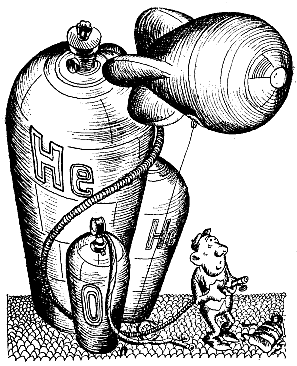107Stories About ChemistryINDEX |
9.
A Solution Which Brought No Consolation
Even Mendeleyev was perplexed at first. He even ventured to suggest the �saving� idea that argon was no new element at all. It was, he said, a sort of compound of nitrogen with three atoms in its molecule: N3; like the ozone molecule O3 which exists alongside the oxygen molecule O2. But finally the facts convinced Mendeleyev of his error and he acknowledged Ramsay to be right. And now all the textbooks in the world name the English scientist as the discoverer of the group of noble gases, and nobody tries to challenge this fact.  For twenty years N. Morozov, a member of the �Narodnaya Volya� group languished in the dungeons of the Schlusselburg Fort. Afterwards, under Soviet power, he became a world renowned scientist. The impenetrable walls of his stone prison were unable to break his will or to keep him away from scientific work. His persistent studies materialized in a number of daring and original ideas and hypotheses. In prison Morozov finished a study devoted to the Periodic System. In it he predicted the existence of elements which should be chemically inactive. By the time Morozov was released, the inert gases had already been discovered and had found their place in the table of elements. It is said that Morozov visited Mendeleyev not long before the latter�s death, and that the two great compatriots had a long talk about the Periodic Law. Unfortunately, the contents of this talk are unknown. Mendeleyev died not long before the mystery of the inertness of the noble gases was solved. The secret was as follows. The physicists who had so often, and still do; come to the aid of the chemists, established that an outer shell containing 8 electrons is very stable. It is a sort of ideal of stability of an electron shell. And hence, there is no reason for it to donate or accept electrons. Thus the reason for the �nobility� of the inert gases is the 8 electrons in their outermost shell (or 2-in the case of the helium atom). The two electron shell of helium is no less stable than the octet ones of the other chemical sloths. And another thing became clear to the chemists: the addition of the zero group to the Periodic Table was not just a forced measure; without it the Periodic System would have looked like an unfinished edifice, because each of its periods ends in an inert gas after which the next electron shell begins to fill up and thus the next storey of the Big House begins to form. As you see, it all turned out quite simple. Despite their aristocratic title, the noble gases exhibited some ability to do practical work: helium found usage for filling balloons and dirigibles and came to the aid of divers against caisson disease. Argon and neon lights decorate city streets at night. But maybe �nevertheless it does move!� Maybe there is something physicists have not thought out or calculated yet, or perhaps chemists have not yet exhausted all the means of making substances react with one another? |





